
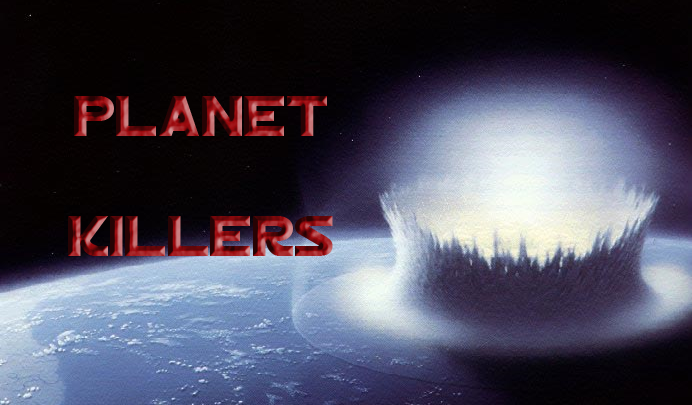
Before the unimaginable resources of the Galactic Empire were funneled into the simultaneous production of some of the galaxy's most fearsome superweapons, more limited means were needed to terrorize and destroy entire planetary populations. The ability to destroy entire planets stretches back thousands of years. Now, as then, smaller, cheaper means of planetary destruction are the rule of the day and are typically just as effective as the superlaser battlestations, some even more so.
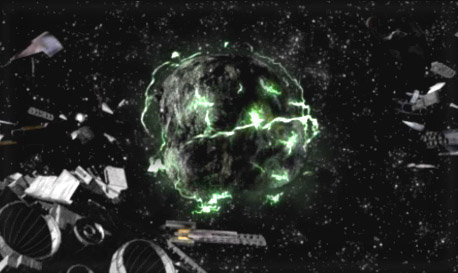 The Jedi and Republic were severely weakened in
the aftermath of The Great Sith War. Seizing upon this
opportunity from the dying embers of galactic conflict, The Mandalorian
Wars began. Mandalorians waged a swift and brutal campaign of
conquest, seizing or destroying many Republic worlds in the early
stages of the war. In desperation, the Jedi and their Republic
allies turned to the Jedi Revan, who advocated adopting the harsh
tactics of the enemy. The tide turned with Revan at the vanguard
of the Republic forces but the war was still one of bitter attrition.
The Jedi and Republic were severely weakened in
the aftermath of The Great Sith War. Seizing upon this
opportunity from the dying embers of galactic conflict, The Mandalorian
Wars began. Mandalorians waged a swift and brutal campaign of
conquest, seizing or destroying many Republic worlds in the early
stages of the war. In desperation, the Jedi and their Republic
allies turned to the Jedi Revan, who advocated adopting the harsh
tactics of the enemy. The tide turned with Revan at the vanguard
of the Republic forces but the war was still one of bitter attrition.
Seeing the opportunity to crush the Mandalorians in one
decisive battle, Revan lured them to Malachor V in 3960 BBY. A
pitched battle ensued until the Mass Shadow Generator was
detonated at Revan's command, obliterating Mandalorian and Republic
forces alike, and shattering Malachor V into a loose collection of
planetoids.
Designed by the Zabrak scientist Bao-Dur, the Mass Shadow Generator focused the gravitational field inherent to all planets, amplifying it to such a degree that Malachor V's core was exposed. The orbiting fleets were drawn into the planet's surface and crushed by intense gravity previously encountered only near black holes. The technology is similar to that used in Gravity Well Generators, but on a far more massive scale.
Although tailored specifically for the unique mass shadow of Malachor V, Bao-Dur believed the technology was adaptable for any world. Little is known of the device itself, except that it had to be on the planet's surface in order to function. The Mass Shadow Generator and the remnants of Malachor V were destroyed in a second firing by the Jedi Exile in 3951 BBY.
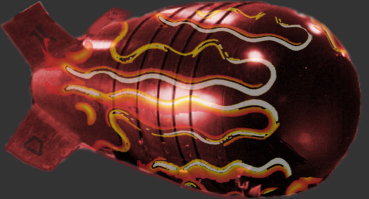 The Baradium Fission Device
is a powerful bomb capable of destroying an entire planet. As the
name implies, it is powered by a large quantity of the unstable
element, baradium. This large unguided bomb weighs approximately
25 tons and fits into the cargo hold of a light freighter. The
weapon's exact origins are a mystery, but it was known to exist during
the Galactic Republic, and officially outlawed in the early days of the
Galactic Empire in legislation authored by Bail Organa.
The Baradium Fission Device
is a powerful bomb capable of destroying an entire planet. As the
name implies, it is powered by a large quantity of the unstable
element, baradium. This large unguided bomb weighs approximately
25 tons and fits into the cargo hold of a light freighter. The
weapon's exact origins are a mystery, but it was known to exist during
the Galactic Republic, and officially outlawed in the early days of the
Galactic Empire in legislation authored by Bail Organa.
One Device is known to have come into the possession of the Rebel
Alliance. An unknown pilot was tasked with carrying the device
aboard his freighter to destroy the Bilbringi shipyards, at that time
maintained by the Empire. The pilot abandoned the mission because
he was unwilling to sacrifice his ship, the Millenium Falcon. The
device's final disposition remains unknown. Due to the extreme
cost of procuring so much baradium and the weapon's inherent
instability, it was largely used as a deterrent, but the Empire is
rumored to have maintained a secret stockpile of these formidable
weapons.
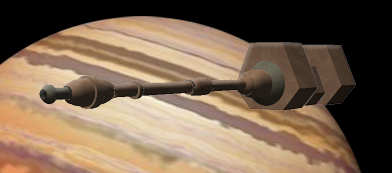
In the wake of the Death Stars' destruction and the Empire's collapse, immense and prohibitively expensive battlestations were impossible to construct after the Emperor's death. Smaller and cheaper means were needed to inspire the same levels of terror. Umak Leth rose to the challenge when he created the Galaxy Gun. 7250 meters long, and equipped with defensive lasers and a hyperdrive, the Galaxy Gun fired particle disintegrator warheads through hyperspace, which impacted their targets with pinpoint accuracy.
The warheads initiated a nuclear chain reaction in previously inert materials that destroyed targets on a molecular level, leaving no residual radiation. Varying levels of destruction were possible, from leveling a city, up to destroying a planet, the reaction was limited only by the amount of power used to power it. The warheads were heavily shielded and armed with short range defensive lasers, allowing them to survive virtually any attack unscathed until detonation above their target.
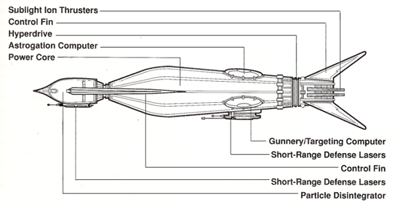 The Galaxy Gun was the most successful of all superweapons
deployed by the late Emperor. After the destruction of the New
Republic Pinnacle Base, projectiles destroyed the worlds of Krinemonen
and Hirsi. A New Republic fleet tasked with destroying the Galaxy
Gun was obliterated by the massive Imperial Fleet guarding the weapon
above Byss. This immense display of power sent many neutral
worlds fleeing into the waiting arms of Imperial forces, greatly
expanding the power and influence of the Imperial Remnant.
The Galaxy Gun was the most successful of all superweapons
deployed by the late Emperor. After the destruction of the New
Republic Pinnacle Base, projectiles destroyed the worlds of Krinemonen
and Hirsi. A New Republic fleet tasked with destroying the Galaxy
Gun was obliterated by the massive Imperial Fleet guarding the weapon
above Byss. This immense display of power sent many neutral
worlds fleeing into the waiting arms of Imperial forces, greatly
expanding the power and influence of the Imperial Remnant.
Virtually unique among Palpatine's superweapons, the Galaxy Gun contained no design flaw or inherent weakness. Rather than exploit a thermal exhaust port, unfinished design, or master control signal, R2-D2 simply took control of the Emperor's flagship, Eclipse II, and rammed the Galaxy Gun, destroying both craft. The impact caused the superweapon to misfire, destroying Byss in the process.